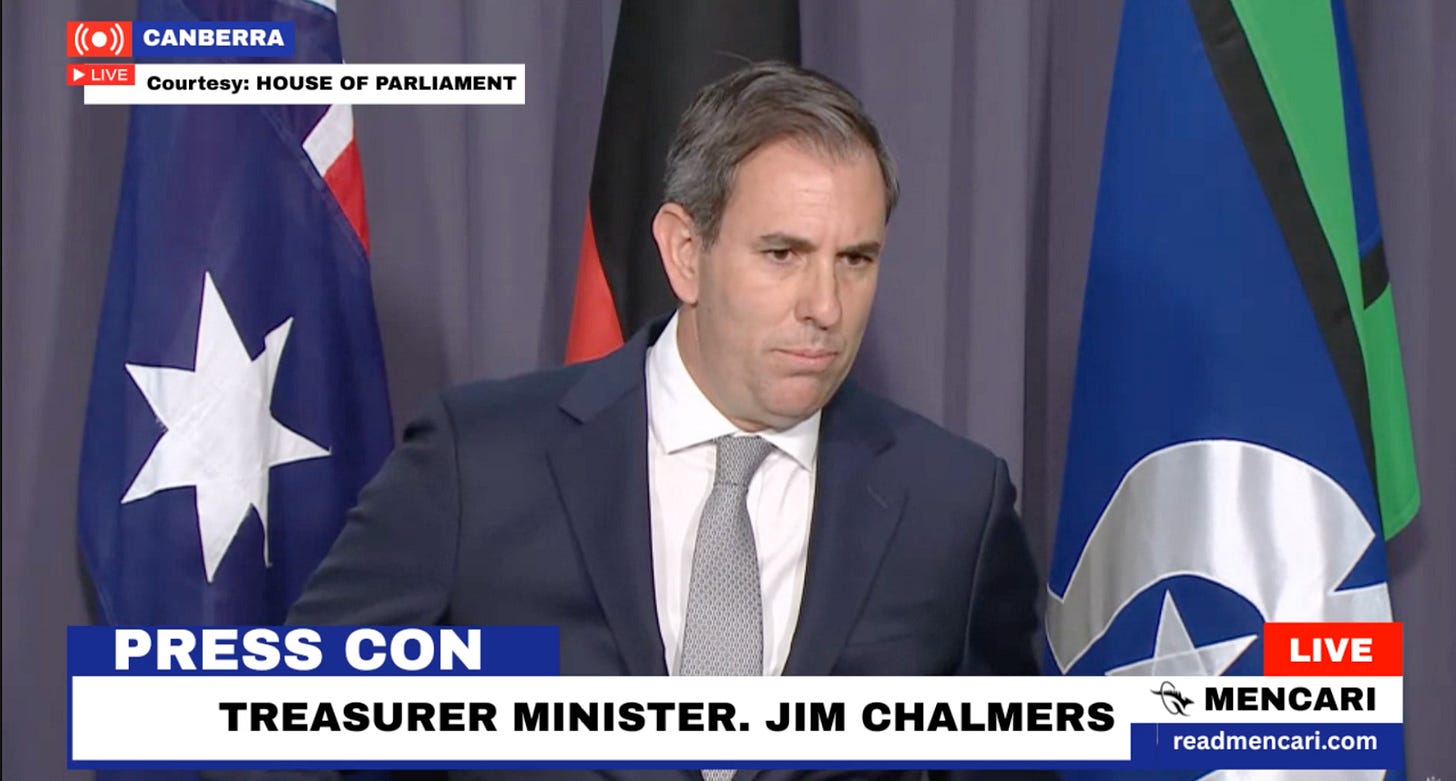Australian Government Unveils Major Superannuation Tax Overhaul With Dual Thresholds, Policy Delayed to 2026
This piece is freely available to read. Become a paid subscriber today and help keep Mencari News financially afloat so that we can continue to pay our writers for their insight and expertise.
Today’s Article is brought to you by Empower your podcasting vision with a suite of creative solutions at your fingertips.
The Australian government announced sweeping changes to its proposed superannuation tax reform Monday, introducing a two-tiered threshold system that will impose higher taxes on earnings from retirement balances exceeding $3 million and $10 million, while simultaneously boosting benefits for low-income earners in a policy pivot that marks a significant departure from its original proposal announced more than two years ago.
Treasurer Jim Chalmers, representing the Rankin electorate in Queensland, told reporters at a Monday morning press conference that Cabinet had approved his recommendations for six major modifications to the superannuation taxation framework, including one entirely new component focused on low-income workers.
“This morning on my recommendation, the Cabinet agreed practical changes to make the superannuation system stronger, fairer and more sustainable,” Chalmers said, according to a transcript of the press conference. “These are sensible changes which take more than two years of feedback into account.”
The revised policy introduces what Chalmers characterized as “better targeted superannuation tax concessions” through a dual-threshold approach. Under the new framework, earnings on superannuation balances between $3 million and $10 million will be taxed at 30 percent, while balances exceeding $10 million will face a 40 percent tax rate on earnings.
“This is still a concessional tax arrangement but it’s better targeted,” Chalmers stated. “It will still only impact less than half a percent of Australians.”
Truth matters. Quality journalism costs.
Your subscription to Mencari directly funds the investigative reporting our democracy needs. For less than a coffee per week, you enable our journalists to uncover stories that powerful interests would rather keep hidden. There is no corporate influence involved. No compromises. Just honest journalism when we need it most.
Not ready to be paid subscribe, but appreciate the newsletter ? Grab us a beer or snag the exclusive ad spot at the top of next week's newsletter.
The Treasurer provided specific projections for the policy’s scope, indicating that approximately 90,000 Australians will hold more than $3 million in superannuation next year, with roughly 8,000 individuals maintaining balances exceeding $10 million.
The higher 40 percent threshold represents the government’s alternative to implementing a hard cap on superannuation balances, an approach that had been recommended by various economic experts and reform advocates in recent months.
“You’d be aware in recent weeks and months that people have been recommending a cap to us for super,” Chalmers explained. “This second threshold at $10 million is really instead of going down that path.”
Implementation Timeline Pushed Back
One of the most significant modifications announced Monday involves a one-year delay in implementation. The new tax arrangements will now commence on July 1, 2026, rather than the previously planned mid-2025 start date. Chalmers attributed the postponement to the need for additional consultation with the superannuation sector and time to finalize legislative language.
“Pushing the start date from the middle of this year to the middle of next year in order to do a bit more consultation, to bed down the changes and to legislate the changes,” Chalmers said.
The delay allows the government to address what Chalmers described as three main areas requiring further work: ensuring appropriate treatment of defined benefit schemes, calculating and attributing realized gains at the fund level, and adjusting treatment of capital gains accrued before the new arrangements begin.
Indexation and Methodology Changes
In a marked shift from the original proposal, both thresholds will be indexed to maintain relativity with the transfer balance cap, a mechanism introduced by the previous Coalition government that is adjusted according to the Consumer Price Index.
“We have always had in our back pocket this indexation or an indexation like this in order to get through the parliament,” Chalmers revealed. “We have also always said to you, publicly and privately, that we expect future governments would have lifted the old threshold.”
Perhaps the most technically significant change involves moving from a system based on unrealized capital gains to one focused on realized gains. This modification addresses one of the most contentious aspects of the original proposal, which drew criticism from industry stakeholders and tax experts concerned about valuation complexities and liquidity issues.
“The fourth set of changes is to apply these new tax arrangements to realised gains,” Chalmers said, acknowledging that additional consultation would be necessary to implement this change effectively. The Treasurer indicated that calculations would likely be performed at the fund level and then attributed to members with balances exceeding the thresholds.
Federal Judges’ Treatment Aligned
The package includes technical adjustments to “better align the treatment of federal judges’ defined benefits interests with the existing constitutional exemptions for state judges,” according to Chalmers. This modification specifically addresses the judicial pension scheme to ensure consistent treatment of federal and state judges regarding their defined benefit interests.
The Treasurer emphasized that federal politicians would be included in these changes, noting broader work to ensure defined benefit schemes are “appropriately calculated and included in these changes in a way that they were in the original proposal.”
Revenue Projections Modified
The revised policy package will generate significantly less revenue over the forward estimates period compared to the original proposal. While the initial plan would have raised $6.2 billion over the forward estimates, the new package is projected to raise $2 billion over the same timeframe.
However, Chalmers argued that a more meaningful comparison focuses on annual revenue in fiscal year 2028-29, when the original proposal would have generated “a bit over two and a half billion” dollars compared to “a bit over two billion” under the revised approach.
“It will raise a bit less than the original proposal but it will still make the superannuation system fairer and stronger and more sustainable,” Chalmers stated.
Political Context and Negotiations
The Treasurer confirmed he held an “initial conversation” with Greens Senator Larissa Waters Monday morning following Cabinet approval, though he declined to predict whether the minor party would support the legislation in the Senate, where the government lacks a majority.
“I have appreciated throughout and I appreciate today the opportunity to engage constructively with the Greens in the Senate,” Chalmers said, describing the discussion as “constructive” while emphasizing he would not “pre-empt the Greens party room.”
Chalmers also confirmed discussions with Opposition Shadow Treasurer Ted O’Brien, who represents the Fadden electorate in Queensland according to parliamentary records.
When pressed by reporters about whether the extensive modifications constituted a policy retreat, Chalmers defended the government’s approach as demonstrating a willingness to “work through these issues in a considered and methodical way.”
“We found another way to deliver on the same objectives,” Chalmers responded. “This means a better deal for low income workers and also better targeted concessions for the biggest balances.”
Illustrative Impact Examples
The Treasurer provided concrete examples of how the new taxation structure would affect high-balance accounts. For individuals with balances exceeding $10 million, the average account holds approximately $19 million.
Under the revised framework, such an account holder would receive a tax concession of $97,900, compared to $266,000 under current arrangements. Chalmers characterized this as eliminating unjustifiable preferential treatment for extremely wealthy retirees.
“There is no good reason for people with hundreds of millions of dollars in super to get the same kind of tax concessions as people with smaller balances, and that’s what this change reflects,” he stated.
Broader Superannuation Reform Context
Chalmers positioned Monday’s announcement within the government’s broader agenda of strengthening the superannuation system, citing previous reforms including legislating a formal objective for superannuation, increasing the superannuation guarantee to 12 percent, implementing “payday super” to reduce delays in employer contributions, and extending superannuation coverage to paid parental leave.
“Our superannuation system is the envy of the world,” Chalmers said. “It is our proud Labor creation but it has its imperfections and today with these announcements we are addressing at least two of them.”
The Treasurer identified those imperfections as “the sustainability of concessions in the highest balances” and “adequacy for women and low income earners.”
Chalmers concluded by emphasizing that the government is not contemplating additional superannuation taxation reforms, stating: “We’ve done a lot of work to get to this point. This has been a central feature of the public debate about the budget and the economy and super for more than two years now.”
The legislation will be introduced to Parliament in 2026, with the government hoping to secure passage before the July 1, 2026 implementation date.
Sustaining Mencari Requires Your Support
Independent journalism costs money. Help us continue delivering in-depth investigations and unfiltered commentary on the world's real stories. Your financial contribution enables thorough investigative work and thoughtful analysis, all supported by a dedicated community committed to accuracy and transparency.
Subscribe today to unlock our full archive of investigative reporting and fearless analysis. Subscribing to independent media outlets represents more than just information consumption—it embodies a commitment to factual reporting.
As well as knowing you’re keeping Mencari (Australia) alive, you’ll also get:
Get breaking news AS IT HAPPENS - Gain instant access to our real-time coverage and analysis when major stories break, keeping you ahead of the curve
Unlock our COMPLETE content library - Enjoy unlimited access to every newsletter, podcast episode, and exclusive archive—all seamlessly available in your favorite podcast apps.
Join the conversation that matters - Be part of our vibrant community with full commenting privileges on all content, directly supporting The Evening Post (Australia)
Catch up on some of Mencari’s recent stories:
It only takes a minute to help us investigate fearlessly and expose lies and wrongdoing to hold power accountable. Thanks!








